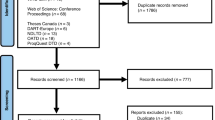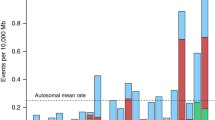Abstract
About one woman in 1,000 has an extra X chromosome, but such women have no recognised characteristic somatic features and little is known about their long-term health and cancer risks. We conducted a cohort study of mortality and cancer incidence in 542 women diagnosed with X polysomy at 25 cytogenetic centres in Britain since 1959. Fifty-nine deaths occurred during follow-up to mid-2004. Mortality was significantly raised (standardised mortality ratio (SMR) = 2.5 (95% confidence interval (CI) 1.9–3.2)), with excess deaths due particularly to cardiovascular disease (SMR = 2.5 (95% CI 1.5–3.8)) and respiratory disease (SMR = 4.0 (95% CI 1.7–7.9)). Risks of cancer incidence and cancer mortality overall were not raised, but there was significantly raised mortality from non-Hodgkin’s lymphoma (NHL) (SMR = 10.4 (95% CI 1.3–37.6); based on 2 cases). The data indicate that mortality in women diagnosed with X polysomy is considerably raised. The raised risk of NHL is seen also in males with more than one X chromosome, and hence although unexpected and based on small numbers, it might indicate the action of a gene on the X chromosome, possibly in the pseudoautosomal region, that escapes X-inactivation.
Similar content being viewed by others
References
Ashley J, Devis T (1992) Death certification from the point of view of the epidemiologist. Popul Trends 67:22–28
Breslow NE, Day NE (1987) Statistical methods in cancer research. Volume II - The Design and Analysis of Cohort Studies. IARC Scientific Publication No. 82. International Agency for Research on Cancer, Lyon
Brown CJ, Greally JM (2003) A stain upon the silence: genes escaping X inactivation. Trends Genet 19:432–438
Carothers AD, Collyer S, de Mey R, Frackiewicz A (1978) Parental age and birth order in the aetiology of some sex chromosome aneuploidies. Ann Hum Genet 41:277–287
Court Brown WM (1969) Sex chromosome aneuploidy in man and its frequency, with special reference to mental subnormality and criminal behavior. Intern Rev Exp Pathol 7:31–97
Gül D, Akin R, Kismet E (2003) Neuroblastoma in a patient with 47,XXX karyotype. Cancer Genet Cytogenet 146:84–85
Holland CM (2001) 47,XXX in an adolescent with premature ovarian failure and autoimmune disease. J Pediatr Adolesc Gynecol 14:77–80
Jacobs PA, Baikie AG, Court Brown WM, MacGregor TN, Maclean N, Harden DG (1959) Evidence for the existence of the human "super female". Lancet ii:423–425
Jacobs PA, Melville M, Ratcliffe S, Keay AJ, Syme J (1974) A cytogenetic survey of 11,680 newborn infants. Ann Hum Genet 37:359–376
Jones KL (1997) Smith’s recognizable patterns of human malformation Fifth edition. W B Saunders, Philadelphia
Khoo SK, Buntine D (1980) Malignant stromal tumour of the ovary with virilizing effects in an XXX female with streak ovaries. Clinical and pathological studies. Aust NZ J Obstet Gynaecol 20:123–128
Linden MG, Bender BG, Harmon RJ, Mrazek DA, Robinson A (1988) 47,XXX: What is the prognosis? Pediatrics 82:619–630
Linden MG, Bender BG, Robinson A (1995) Sex chromosome tetrasomy and pentasomy. Pediatrics 96:672–682
Mantle DJ, Pye C, Hardisty RM, Vessey MP (1971) Plasma factor-VIII concentrations in XXX women. Lancet i:58–59
Michalak DP, Zacur HA, Rock JA, Woodruff JD (1983) Autoimmunity in a patient with 47,XXX karyotype. Obstet Gynecol 62:667–669
Nielsen J, Wohlert M (1991) Sex chromosome abnormalities found among 34,910 newborn children: results from a 13-year incidence study in Århus, Denmark. Birth Defects Orig Artic Ser 26:209–223
Patiño-García A, López de Mesa R, de Alava E, Sierrasesúmaga L (1999) Clinical and molecular features of Ewing sarcoma in a patient with triple-X syndrome. Cancer Genet Cytogenet 113:188–190
Price WH, Clayton JF, Collyer S, de Mey R (1987) Mortality and causes of death in females with extra X chromosomes and males with extra Y chromosomes. J Epidemiol Community Health 41:1–4
Ratcliffe S (1999) Long term outcome in children of sex chromosome abnormalities. Arch Dis Child 80:192–195
Robinson A, Bender BG, Linden MG (1991) Summary of clinical findings in children and young adults with sex chromosome anomalies. Sponsored by the National Foundation - March of Dimes. Birth Defects Orig Artic Ser 26:225–228
Sills JA, Brown JK, Grace E, Wood SM, Barclay GR, Urbaniak SJ (1978) XXX syndrome associated with immunoglobulin deficiency and epilepsy. J Pediatr 93:469–471
Swerdlow A, dos Santos Silva I, Doll R (2001a) Cancer incidence and mortality in England and Wales: trends and risk factors. Oxford University Press, Oxford
Swerdlow AJ, Hermon C, Jacobs PA, Alberman E, Beral V, Daker M, Fordyce A, Youings S (2001b) Mortality and cancer incidence in persons with numerical sex chromosome abnormalities: a cohort study. Ann Hum Genet 65:177–188
Swerdlow AJ, Schoemaker MJ, Higgins C, Wright AF, Jacobs PA, on behalf of the UK Clinical Cytogenetics Group (2005). Cancer incidence and mortality in patients with Klinefelter’s syndrome: a cohort study. J Natl Cancer Inst 97:1204–1210
Witek A, Skalba P, Zieba M (2001) Pituitary tumor in a woman with a 47,XXX karyotype–case report. Med Sci Monit 7:304–307
Acknowledgements
We thank the Medical Research Council for funding, D Allen, F Barber, C Maguire, P Murnaghan, M Pelerin and M Swanwick for assistance in data collection; E Boyd, D Couzin, J Delhanty, P Ellis, M Faed, J Fennell, A Kessling, A McDermott, A Parkin, A Potter and D Ravine for access to data, N Mudie and A Hart for help in coding, H Nguyen for data entry, Z Qiao for computer programming, N Dennis for advice, the NHSCRs and cancer registries of England, Wales and Scotland for follow-up data.
Author information
Authors and Affiliations
Corresponding author
Additional information
On behalf of the UK clinical cytogenetics group
Appendices
Appendix
The group comprises:
The named authors above, plus Paul J Batstone (Inverness Genetics Laboratory), Leslie J Butler (NE Thames, Great Ormond Street Hospital Genetics Laboratory), Teresa Davies (Bristol Genetics Laboratory), Valerie Davison (Birmingham Genetics Laboratory), Zoe Docherty (SE Thames, Guy’s Hospital Genetics Laboratory), David P Duckett (Leicestershire Genetics Centre), Margaret Fitchett (Oxford Genetics Laboratory), Alison Fordyce (MRC Human Genetics Unit, Edinburgh); Lorraine Gaunt (Manchester Genetics Laboratory), Elizabeth Grace (Edinburgh Genetics Laboratory), Peter Howard (Liverpool Genetics Laboratory), Gordon W Lowther (Glasgow Genetics Laboratory), Christine Maliszewska (Dundee Genetics Laboratory), Edna L Maltby (Sheffield Genetics Laboratory), Kevin P Ocraft (Nottingham Genetics Laboratory), Selwyn Roberts (Wales Genetics Laboratory), Kim K Smith (Cambridge Genetics Laboratory), Gordon S Stephen (Aberdeen Genetics Laboratory), John W Taylor (SW Thames, St George’s Hospital Genetics Laboratory), Catherine S Waters (NW Thames, Northwick Park Hospital Genetics Laboratory), Jeffery Williams (Leeds Genetics Laboratory), John Wolstenholme (Newcastle Genetics Laboratory), Sheila Youings (Wessex Regional Genetics Laboratory).
Rights and permissions
About this article
Cite this article
Swerdlow, A.J., Schoemaker, M.J., Higgins, C.D. et al. Mortality and cancer incidence in women with extra X chromosomes: a cohort study in Britain. Hum Genet 118, 255–260 (2005). https://doi.org/10.1007/s00439-005-0043-7
Received:
Accepted:
Published:
Issue Date:
DOI: https://doi.org/10.1007/s00439-005-0043-7




